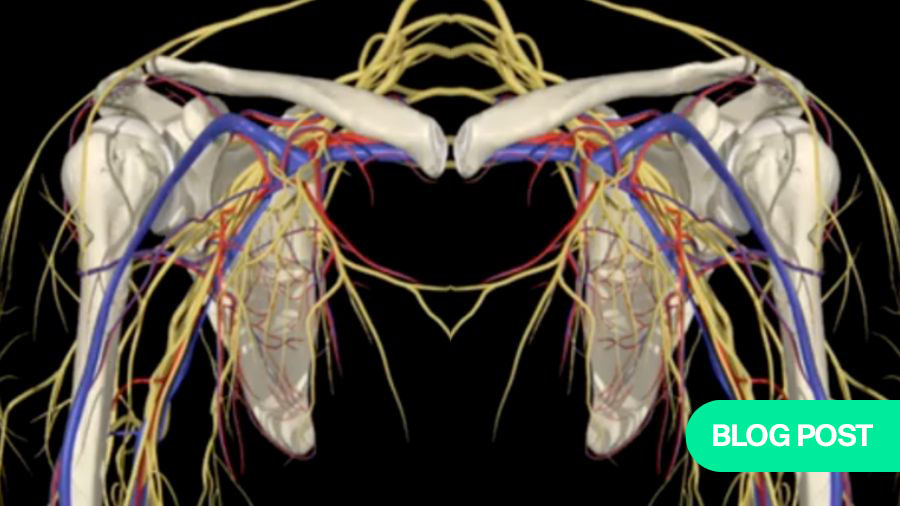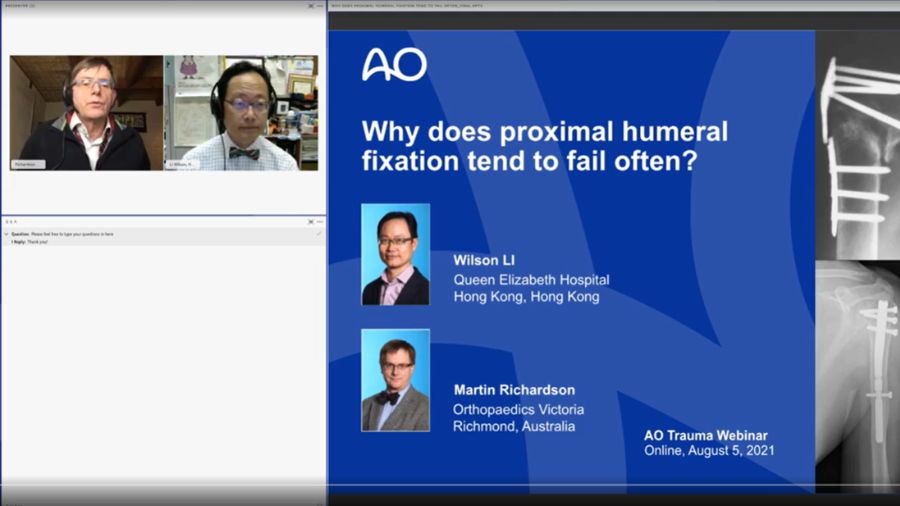Why proximal humeral fixation often fails: understanding the key pitfalls and how to avoid them
WITH DR WILSON LI

Proximal humeral fractures (PHF) are common injuries, especially in older patients, and they present a significant challenge to trauma surgeons. While surgical fixation can often be the best option, the reality is that it is associated with high rates of complications and failures. Studies suggest that up to 37% of patients experience complications after open reduction and internal fixation (ORIF), with failure rates for certain fixation methods reaching around 34%. What’s even more concerning is that in older patients with more complex fractures, these rates can be even higher.
-
Read the quick summary:
- The article discusses proximal humeral fixation failures, highlighting key decision-making and execution errors that contribute to poor surgical outcomes.
- Proper implant selection, anatomical reduction, and medial support are critical to preventing fixation failure and improving patient outcomes.
- Surgeons should optimize preoperative planning, use precise surgical techniques, and ensure stable fixation to reduce complications and enhance success rates.
Disclaimer: The article represents the opinion of individual authors exclusively and not necessarily the opinion of AO or its clinical specialties.
Given these high failure rates, it's crucial to understand why PHF fixation fails and what can be done to improve outcomes. While factors such as bone quality, fracture complexity, and patient age play a role, many failures are related to specific technical errors during both decision-making and surgical execution. This post will examine the key reasons why proximal humeral fixation tends to fail and provide guidance on how to mitigate these risks.
Common decision-making errors in fixation
1. Is fixation the most appropriate solution?
The first and most fundamental question is whether surgical fixation is the best choice for the patient, particularly in cases involving older adults with complex fractures. Many of these patients are at high risk for avascular necrosis (AVN), a condition where the bone loses its blood supply, leading to tissue death and eventual collapse. Surgeons must assess whether the arterial blood supply to the humeral head is adequate and if the remaining bone stock can support the fixation.
Key Considerations:
- Blood Supply: If the arterial blood supply to the humeral head is compromised (especially with femoral neck fractures or extensive comminution), fixation may fail.
- Bone Stock: Overestimating the strength of osteoporotic bone is a common error. Surgeons need to consider the integrity of the bone before choosing the fixation method.
- Calcar Integrity: The medial calcar plays a crucial role in the stability of the fracture. Disruption or comminution of the calcar can lead to significant complications, including a 75% risk of AVN in four-part fractures.
2. Assessing bone quality: osteoporosis
Older patients often have osteoporotic bone, which makes the fixation less stable and more prone to failure. Underestimating bone density can lead to improper choice of fixation device, especially since most internal fixation implants are designed for non-osteoporotic bone. Surgeons should be mindful of bone quality, using tools like DEXA scans or quantitative CT to assess bone mineral density before surgery.
3. Medial Calcar Integrity: a critical factor
The integrity of the medial calcar is a critical factor in fixation success. If there is significant comminution or disruption of the medial hinge, special attention must be paid to stabilizing the area. A well-placed calcar screw or allograft may be necessary to prevent collapse and improve the overall construct stability.
Execution errors that lead to failure
While decision-making errors are a significant contributor to fixation failure, technical execution is equally important. Even if the decision to proceed with fixation is correct, poor surgical technique can lead to suboptimal outcomes.
1. Inappropriate surgical approach
Selecting the wrong surgical approach can cause significant damage to surrounding structures and compromise fixation. For example, the deltopectoral approach and the transdeltoid anterolateral approach are commonly used, but each comes with risks to the neurovascular structures around the humerus. Surgeons must be cautious to avoid damaging the axillary nerve or the posterior circumflex humeral artery.
2. Inadequate reduction
Even when a proper surgical approach is chosen, the quality of the fracture reduction plays a major role in fixation success. A mal-reduced fracture can result in poor alignment of the humeral head, increasing the risk of complications such as shoulder impingement or arthritis. Surgeons should ensure that the neck-shaft angle and humeral head height are restored anatomically before securing the fixation.
3. Choosing the wrong implant construct
Selecting the appropriate implant construct is crucial for fixation success. Not all plates and screws are created equal, and using an implant with poor biomechanical properties can lead to failure. For example, some plates are better suited for supporting medial calcar integrity, while others might not offer adequate angular stability. Surgeons must choose an implant that best suits the specific fracture pattern and patient needs.
How to improve outcomes for proximal humeral fixation: best practices
To reduce the risk of fixation failure, trauma surgeons must focus on both preoperative decision-making and technical execution. Here are some key steps to follow:
1. Evaluate Bone Stock and Fixation Feasibility
Before proceeding with surgery, assess whether the bone can adequately support the fixation. Consider non-surgical options in cases where fixation may not provide significant benefit.
2. Use Accurate Radiographic Assessments
Preoperative imaging should include detailed radiographs to assess fracture type and bone quality. If necessary, employ DEXA scans or CT to better understand bone density.
3. Ensure Optimal Reduction
Achieving a stable anatomical reduction is the key to fixation success. Use techniques such as intraosseous sutures or K-wires to perfect the reduction before inserting the implant.
4. Choose the Right Implant
Select an implant that is biomechanically suitable for the fracture type and patient, ensuring adequate angular stability and medial support.
5. Avoid Surgical Pitfalls
Be mindful of potential complications like neurovascular damage and ensure a precise surgical approach. Proper patient positioning and careful dissection are crucial to avoid inadvertent damage.
How to reduce complications of proximal humeral fixation:
It is essential to be aware of the risk factors in fixation failure:
- malreduction
- inadequate medial support
- inadequate angular stability, resulting, e.g., from a failure to incorporate tension band sutures over the tuberosity fragments.
By dealing proactively with these three points, we can avoid technical errors and prevent fixation failure. It is advisable to aim at a perfect anatomical reduction before your fixation. If that is not possible, try to achieve a slightly impacted but stable reduction. After that, incorporate a calcar screw. Use an inferomedial-directed screw for fixation of the reconstructed medial calcar. This is very important to prevent late varus collapse.
Regardless of whether using a plate or a screw, a minimum of five equally distributed divergent fixed-angle screws should be inserted in the humeral head to provide adequate angular stability, which will prevent fixation failure. The implant, despite the advancements in technology it represents, is just a tool—not an entire surgical principle. It does not compensate for poor patient selection, inadequate reduction, or an unstable fixation construct. Therefore, it is important to stick to the appropriate principles in fixation. Otherwise, the risk of failures of our own decision-making or execution increases. Regardless of whether the implant is used with a plate or a nail, it is almost never the cause of failure. Failures that result from technical errors should not be counted as fixation failures, but as surgeon failures. If we discount technical errors from the reported series, I suspect we will arrive at a far lower rate of fixation failure.
Proximal humeral fixation failure is often the result of a combination of decision-making and execution errors. However, by understanding the key factors that contribute to failure—such as inadequate reduction, poor implant selection, and lack of medial support—surgeons can improve their approach and reduce complication rates. With careful preoperative planning, attention to bone quality, and flawless surgical technique, the rates of fixation failure can be significantly lowered, leading to better outcomes for patients suffering from proximal humeral fractures.
Watch the recording of the AO Webinar - Why Does Proximal Humeral Fixation Tend to Fail Often? where Wilson Li and Martin Richardson present about problems in proximal humeral fixation with images and example cases. AO members have full access:
About the expert:
Dr Wilson Li, MBBS, FRCS (Edin), FRCS (Glasg), FCSHK, FHKCOS, FHKAM(Ortho), FACS, specializes in orthopaedic sports medicine and trauma surgery is consultant surgeon and the Director of Sports Medicine and Arthroscopy Service in the Department of Orthopaedics and Traumatology at Queen Elizabeth Hospital, the largest hospital in Hong Kong.
Li is an active member of the International Society for Arthroscopy, Knee Surgery and Orthopaedic Sports Medicine (ISAKOS), and the International Cartilage Repair Society (ICRS), and the founding President of the Sports Medicine Chapter at the Hong Kong Orthopaedic Association. He is a board member of Doctors Without Borders (MSF) and actively volunteers in numerous other charitable organizations.
You might also be interested in:
The AO Trauma upper extremity curriculum
This curriculum provides a robust and flexible educational framework.
AO Trauma videos and webinars library
First-class videos for educational purposes produced by leading AO Trauma surgeons.
New AO Trauma Orthogeriatrics App
Your go-to app for managing fragility fractures in older adults.




